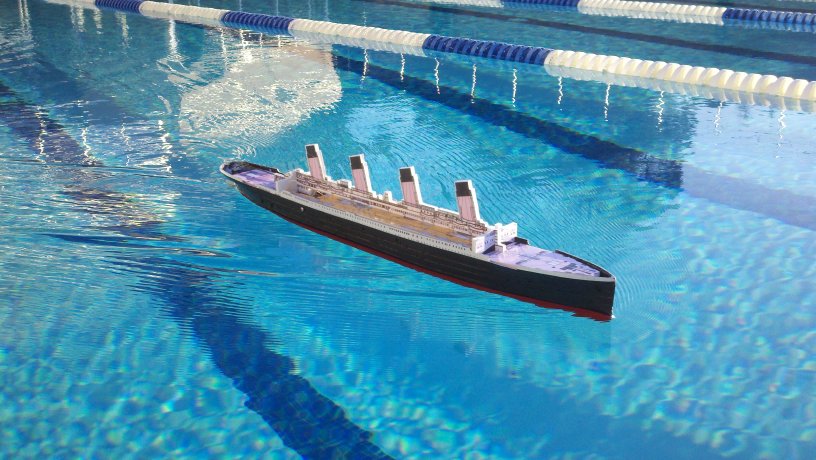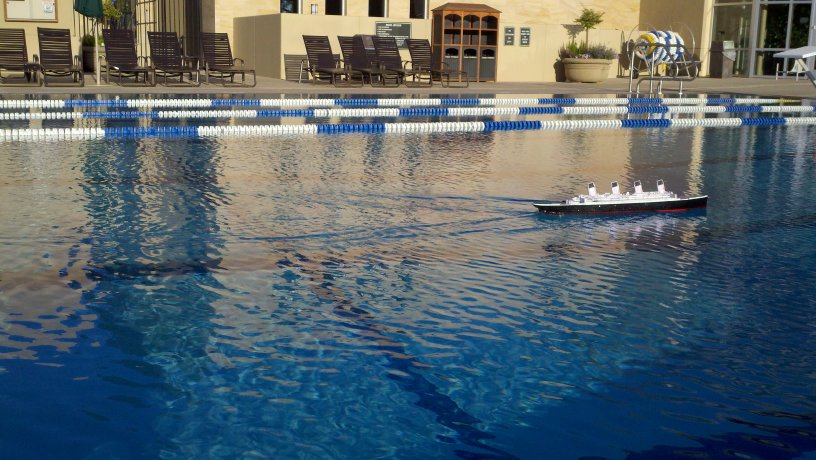About a month ago, I finally had the chance to run the Titanic in the pond-fountain near J’s house, and it didn’t last long. While it was running it was pretty good, though between turns, the wind, and the natural instability of the ship, there were definitely moments where I feared it would flip. Then I drove it off of a wall and into a debris field and lost my only propeller in the process.
So that was that. I didn’t intend to get it back out on the water again this season, but obviously, fate intervened. Through some sequence of events, I made a trip out to a “local” J&M Hobby with some of my siblings and some family friends, and I asked them if they had any propellers for model boats and the like.

As it turns out, they did.
The axle hole (about 1.5-2mm) was far too big for my engine shaft (about 0.5-1mm), but it was nothing a bit of heat-shrink tubing (thank you J) and a bit of Technic tubing (thank you Lego) couldn’t fix. Static testing immediately after installation of the new screw suggested that the new screw put out thrust comparable to that put out by the old prop, while not rocking the boat as much. Thinking I might finally be on the way to solving the so far insolvable stability issue, I also unscrewed the battery box from the sides of the hull, letting it sit on the “floor” and lowering the center of mass by maybe half a centimeter.
And thus, one lovely evening after stopping at the FedEx, I decided it was time to put out to sea for a third time this summer.
I found that, together, the two aforementioned patches seem to have mostly taken care of the ship’s natural rolling problem, though wind is still a bit of a wildcard, given the foam-core superstructure’s sail-like qualities.
This video shows a 25 yard run at approximately full speed with captain Maxwell Kim at the helm. You can see the boat list a little at the beginning, a combination of wind and acceleration, but it remains by and large upright throughout the run. Top speed does seem to be a little bit slower with the new prop, but it’s almost certainly a single-percent decrease in speed. Also of note is the enormous wake that follows the ship; I’m not sure if this is due to the relative inefficiency of what is effectively a 19th century hull or the fact that it’s cruising at some twenty times the intended scale speed. Either way, that Solar Motor #2 puts up a good show.
This second clip shows a figure-eight. Maneuverability is obviously no where near as good as that of Lucky Channel, but I think a turning radius of about two boat-lengths at near “mach 1” (this is the estimated scale speed of the ship, given an absolute straight-line speed of about a yard per second. Obviously the full speed doing a figure-eight isn’t going to be quite as fast, but I do believe captain Kim has the pedal floored in this video) is pretty good considering the real Titanic had a turning radius twice the size at a twentieth of the scale speed.

Overall, a very successful excursion this time around… though I would have loved to have her out on the pond near J’s place. There were no mechanical faults, nor any instances during which I feared for the safety of the vessel (hell I tried to run straight into a wall once just to see what would happen). The hull does a leak a little, despite my various hot-melt plugs and buttering of the output shaft (no vasaline in house, apparently), but a couple milliliters of water after about half an hour of sailing isn’t much for a hull of maybe five or six liters. The weakest link right now is probably the still relatively shoddy rudder construction. It doesn’t affect turning performance much, but the poor fit of all the parts back there does make it such that I can’t trim the ship to sail in a straight line.
A project for next season (or maybe winter), though.